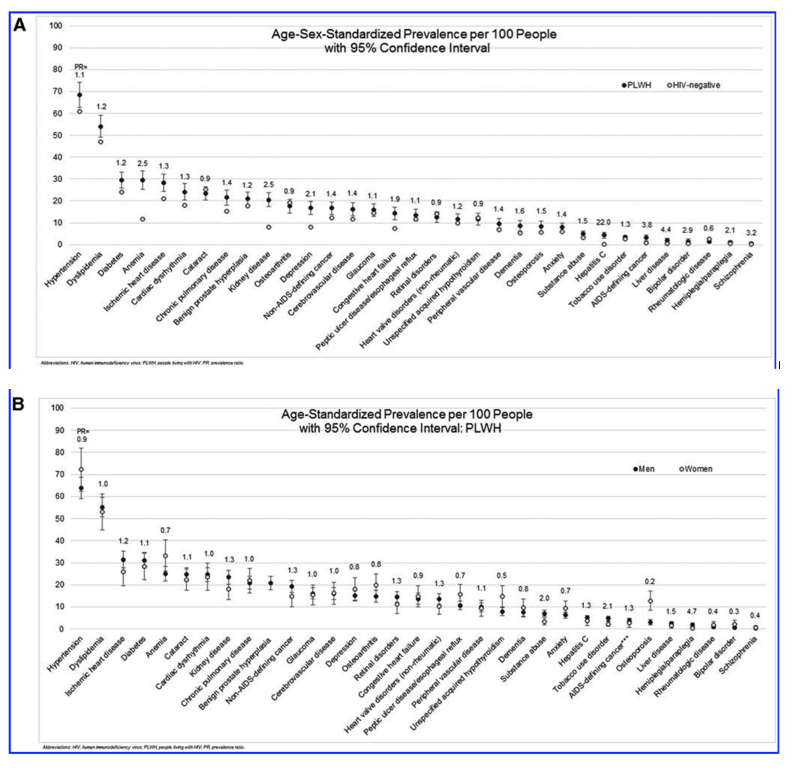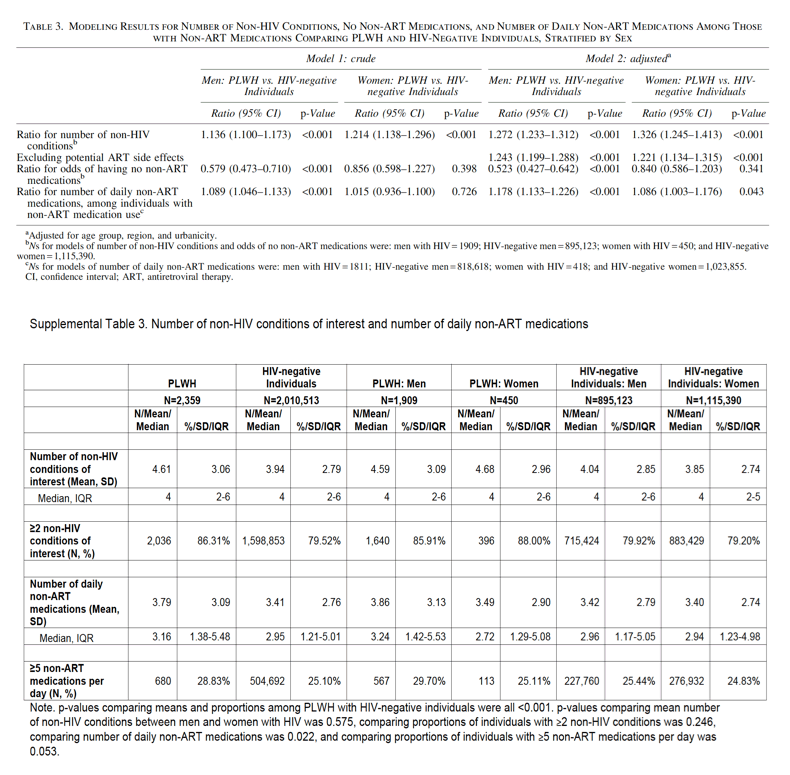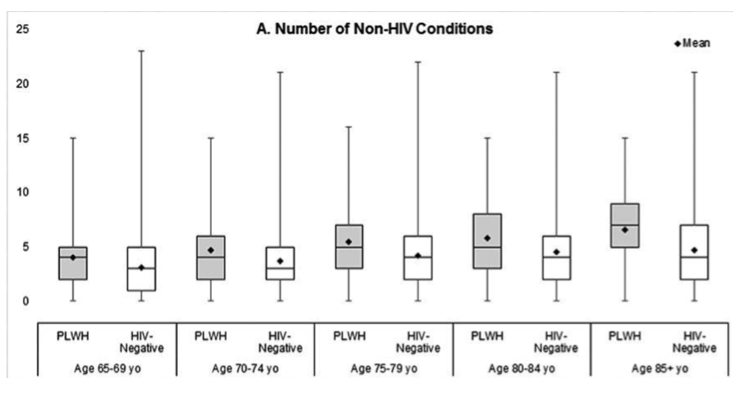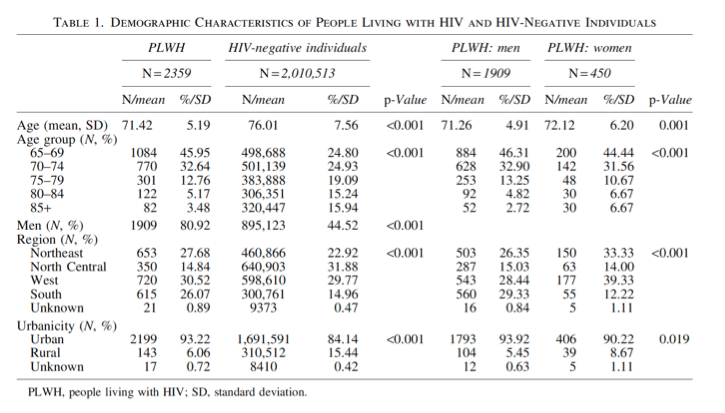| |
HIV+ 70-74 Have Same # of Comorbidities as HIV-Neg >85, Similarly for polypharmacy. Medicare study
Non-HIV Comorbid Conditions and Polypharmacy Among People Living with HIV Age 65 or Older Compared with HIV-Negative Individuals Age 65 or Older in the United States: A Retrospective Claims-Based Analysis
|
| |
| |
Download the PDF
Download the PDF
...... # of Comorbidities: PLWH 70-74 years old were similar to HIV-negative individuals ≥85 years [PLWH mean = 4.69 (median = 4) vs. HIV-negative = 4.70 (4)].......# of daily medications(polypharmacy): PLWH 70-74 years old resembling HIV-negative individuals aged 80-84 [PLWH mean = 3.88 (median = 3.18) vs. HIV-negative = 3.83 (3.48)].
From Jules: this is 1 of many studies reporting province of comorbidities among older HIV+ vs HIV-neg. In this study PLWH over 65 through 85 had increasingly greater prevalence of. Comorbidities as they seed vs HIV-neg. I find this study compared to many others underestimates the affects of comorbidities on older aging HIV. There is no data in here on frailty, falls & cognitive impairment although depression is much greater in prevalence among HIV+ and higher among HIV+ women than for HIV+ men. Much Higher Rates of Kidney disease among PLWH stands out in this study, but also heart disease, diabetes, dyslipidemia, hypertension, osteoporosis, schizophrenia & bipolar stand out in Figure 2a just below. There is no doubt to me that older aging HIV+ suffer much more disparately due to the aging consequence vs HIV-neg, we get them earlier, in greater numbers, more polypharmacy. What this study does not look at is - the percent among HIV+ vs HIV-neg that are much greater affected with large numbers of comorbidities & frailty & cognitive impairment & unable tp function physicall7 Mentally & the study does not look at the quality of care & ability navigate the healthcare systems & access to services.
Amanda M. Kong, MPH,1,2Alexis Pozen, PhD,3Kathryn Anastos, MD,4Elizabeth A. Kelvin, PhD,1and Denis Nash, PhD, MPH
Published Online:7 Mar 2019
Mean age was significantly lower for PLWH than HIV-negative individuals (71.42 vs. 76.01 years, p < 0.001; Table 1).
Age was found to be a strong positive predictor of both the number of non-HIV conditions and daily non-ART medications (Supplementary Tables S4A-C).
After age-sex standardization, hypertension and dyslipidemia remained the most prevalent non-HIV conditions for both PLWH and HIV-negative individuals (Fig. 1A). However, the rates were higher among PLWH than HIV-negative individuals [hypertension = 68.4 per 100 (95% CI 62.6-74.2) vs. 60.9 (60.8-61.0); dyslipidemia = 54.0 per 100 (95% CI 49.1-59.0) vs. 46.9 (46.8-47.0)]. Most conditions examined were more prevalent among PLWH. The largest absolute differences were seen in anemia [29.6 per 100 (95% CI 25.4-33.8) vs.11.7 (95% CI 11.6-11.7)] and kidney disease [20.5 per 100 (95% CI 17.4-23.7) vs. 8.1 (95% 8.0-8.1)]. The largest relative differences were found among less prevalent conditions: hepatitis C (PRPLWH vs. HIV-negative = 22.0), liver disease (PRPLWH vs.
HIV-negative = 4.4), and schizophrenia (PRPLWH vs. HIV-negative = 3.2). AIDS-defining cancer was also more prevalent among PLWH (PRPLWH vs. HIV-negative = 3.8). Among PLWH, large differences in age-standardized prevalence rates were noted in the prevalence of osteoporosis that was more common among women [PLWH men = 3.0 per 100 (95% CI 1.9-4.2) vs. PLWH women = 12.9 (95% CI 8.5-17.2); PRmen vs. women = 0.2] and hemiplegia/paraplegia that was more common among men [PLWH men = 1.9 (95% CI 0.9-2.8) vs. PLWH women = 0.4 (95% CI 0-0.9); PRmen vs. women = 4.7] (Fig. 1B). Comparisons of prevalence rates between HIV+ men and HIV-negative men and HIV+ women and HIV-negative women were similar to the overall PLWH and HIV-negative comparisons (Supplementary Fig. S2A, B).
The number of non-HIV conditions and daily non-ART medications increased with age for both PLWH and HIV-negative individuals (Fig. 2A, B). Within each age stratum, the number of non-HIV conditions was higher for PLWH. The mean and median number of conditions for PLWH aged 65-69 was similar to those HIV-negative individuals aged 75-79 [PLWH mean = 4.02 (median = 4) vs. HIV-negative = 4.21 (4)] whereas PLWH 70-74 years old were similar to HIV-negative individuals ≥85 years [PLWH mean = 4.69 (median = 4) vs. HIV-negative = 4.70 (4)]. Trends were similar when evaluating daily non-ART medications with PLWH 65-69 years old resembling HIV-negative individuals 70-74 years old [PLWH mean = 3.58 (median = 2.92) vs. HIV-negative = 3.62 (3.21)] and PLWH 70-74 years old resembling HIV-negative individuals aged 80-84 [PLWH mean = 3.88 (median = 3.18) vs. HIV-negative = 3.83 (3.48)].
In models, PLWH had significantly more non-HIV conditions than HIV-negative individuals [ratios: men = 1.272, (95% confidence interval, 1.233-1.312); women = 1.326 (1.245-1.413)]. Among those with >0 daily non-ART medications, men with HIV had significantly more non-ART medications than HIV-negative men [ratio = 1.178 (1.133-1.226)]. The disease burden associated with aging is substantially higher among PLWH, who may require additional services to effectively manage HIV and comorbid conditions.
Caring for these patients will involve managing multiple non-HIV conditions and multiple non-ART medications, in addition to HIV and ART.
Multimorbidity and polypharmacy among elderly PLWH are of significant clinical concern. Comorbidities like chronic kidney disease and cardiovascular disease have been associated with increased 5-year mortality48 and a higher number of comorbidities has been associated with lower self-reported quality of life in both HIV+ and HIV-negative individuals.49 In the general population, polypharmacy has been associated with short-term mortality, frailty, disability, and adverse drug events.50-54
The potential mechanisms by which HIV infection may result in multimorbidity include chronic inflammation and immune compromise by the virus, side effects of ART that negatively influence ART adherence or that develop into chronic conditions, or the higher prevalence of traditional risk factors for certain chronic conditions among PLWH.8,9 Longer duration of HIV infection has been found to drive comorbidity prevalence independent of age.6 Even PLWH with successfully controlled HIV have higher mortality rates compared with age-matched HIV-controls.63 ART is also associated with adverse events, including decreases in bone density, dyslipidemia, hepatitis/liver disease, and chronic kidney disease;25 however, an increased disease burden was still associated with HIV when these conditions were excluded. Additionally, the increased number of comorbidities reported among PLWH may be due to higher prevalence of disease risk factors, such as smoking and substance abuse.28,39
This study also has limitations. First, claims are generated for billing purposes. There may be coding errors. Patients may receive a misdiagnosis that is recorded in claims and conditions for which they do not seek care will not appear in the database. Health care services covered by other insurance plans, such as Medicaid, or paid for out-of-pocket would also not appear in the database. HIV status was inferred from claims and misclassification may have occurred if patients in the HIV-negative cohort had undiagnosed or untreated HIV. However, the proportion of undiagnosed patients is likely very small relative to our total number of HIV-negative individuals and therefore, is unlikely to have affected our conclusions. Second, race, socioeconomic status, lifestyle behaviors, and HIV-related variables, such as disease duration, viral load, and CD4 counts, are not available in claims data. Because of this limitation, we could not evaluate potential causal relationships between HIV duration, ART use, or risk factors and multimorbidity or polypharmacy. Substance abuse and tobacco use disorder are likely under-coded.
Third, we assumed that patients took their medications as directed (e.g., a 30-day fill was taken for 30 days). The calculation of daily medications did not account for the length of time on the medication. Medications for short-term conditions, such as antibiotics for infection, contributed to the calculation for this analysis, while over-the-counter medications are not included. Fourth, the individuals analyzed had Medicare Supplemental and likely have higher socioeconomic status and more generous medical and pharmacy benefits than other elderly PLWH, limiting generalizability. Despite having more women than other studies, the number of HIV+ women was still small and more research is needed to evaluate multimorbidity and polypharmacy in women. Lastly, PLWH may be in more contact with health care providers than HIV-negative individuals, which may result in more frequent screenings for and earlier diagnosis of non-HIV conditions and more prescriptions.



Non-HIV Comorbid Conditions and Polypharmacy Among People Living with HIV Age 65 or Older Compared with HIV-Negative Individuals Age 65 or Older in the United States: A Retrospective Claims-Based Analysis
Amanda M. Kong, MPH,1,2Alexis Pozen, PhD,3Kathryn Anastos, MD,4Elizabeth A. Kelvin, PhD,1and Denis Nash, PhD, MPH
Published Online:7 Mar 2019
1Department of Epidemiology and Biostatistics, City University of New York, Graduate School of Public Health and Health Policy,New York, New York.2Department of Life Sciences, IBM Watson Health, Cambridge, Massachusetts.3Department of Health Policy and Management, City University of New York, Graduate School of Public Health and Health Policy,New York, New York.4Albert Einstein College of Medicine, Bronx, New York.

Most common diagnoses and medications
The diagnoses ranked first, second, and third among both PLWH and HIV-negative individuals were essential hypertension (ICD-9-CM 401; PLWH = 47.9% vs. HIV-negative = 59.4%), disorders of lipid metabolism (ICD-9-CM 272; 35.7% vs. 46.9%), and symptoms involving respiratory system and other chest symptoms (ICD-9-CM 786; 31.3% vs. 26.3%; Table 2). Differences in rank were noted for diagnoses of symptoms involving the urinary or digestive symptoms (ICD-9-CM 788 and 787), which were more highly ranked and more common among PLWH (ranked 15 and 16th most common among PLWH vs. 27th and 28th among HIV-negative individuals). Other retinal disorders (ICD-9-CM 362) and osteoarthritis and allied disorders (ICD-9-CM 715) were ranked higher among HIV-negative individuals (ranked 15th and 11th most common among HIV-negative individuals vs. 28th and 29th among PLWH). For both PLWH and HIV-negative individuals, therapeutic medication classes related to heart conditions were commonly used (ranks first, second, fourth, and fifth most common among PLWH vs. ranks first through fourth among HIV-negative individuals). Non-HIV antiviral medications, including those used for influenza, viral hepatitis, cytomegalovirus, and herpes, were more common among PLWH than among HIV-negative individuals (ranked 11th most common among PLWH vs. outside of the top 20 conditions for HIV-negative individuals). Thyroid medications were ranked higher among HIV-negative individuals than PLWH (ranked 10th most common among HIV-negative individuals vs. 31st among PLWH).
Diagnoses of other forms of chronic ischemic heart disease (ICD-9-CM 414, such as coronary atherosclerosis and aneurysm of heart or coronary vessels), of other dermatoses (ICD-9-CM 702, such as actinic or seborrheic keratosis), and of symptoms involving the urinary system (ICD-9-CM 788) were ranked higher and were more common among men living with HIV compared to women living with HIV, whereas special screening for malignant neoplasms (ICD-9-CM V76), other and unspecified anemias (ICD-9-CM 285), and osteoarthritis and allied disorders were ranked higher among women with HIV (Supplementary Table S2). Unclassified agents (which include medications for benign prostate hyperplasia) and non-HIV antivirals were more highly ranked among men living with HIV than women living with HIV.
Prevalence of non-HIV conditions
After age-sex standardization, hypertension and dyslipidemia remained the most prevalent non-HIV conditions for both PLWH and HIV-negative individuals (Fig. 1A). However, the rates were higher among PLWH than HIV-negative individuals [hypertension = 68.4 per 100 (95% CI 62.6-74.2) vs. 60.9 (60.8-61.0); dyslipidemia = 54.0 per 100 (95% CI 49.1-59.0) vs. 46.9 (46.8-47.0)]. Most conditions examined were more prevalent among PLWH. The largest absolute differences were seen in anemia [29.6 per 100 (95% CI 25.4-33.8) vs.11.7 (95% CI 11.6-11.7)] and kidney disease [20.5 per 100 (95% CI 17.4-23.7) vs. 8.1 (95% 8.0-8.1)]. The largest relative differences were found among less prevalent conditions: hepatitis C (PRPLWH vs. HIV-negative = 22.0), liver disease (PRPLWH vs.
HIV-negative = 4.4), and schizophrenia (PRPLWH vs. HIV-negative = 3.2). AIDS-defining cancer was also more prevalent among PLWH (PRPLWH vs. HIV-negative = 3.8). Among PLWH, large differences in age-standardized prevalence rates were noted in the prevalence of osteoporosis that was more common among women [PLWH men = 3.0 per 100 (95% CI 1.9-4.2) vs. PLWH women = 12.9 (95% CI 8.5-17.2); PRmen vs. women = 0.2] and hemiplegia/paraplegia that was more common among men [PLWH men = 1.9 (95% CI 0.9-2.8) vs. PLWH women = 0.4 (95% CI 0-0.9); PRmen vs. women = 4.7] (Fig. 1B). Comparisons of prevalence rates between HIV+ men and HIV-negative men and HIV+ women and HIV-negative women were similar to the overall PLWH and HIV-negative comparisons (Supplementary Fig. S2A, B).
FIG. 1. (A, B) Standardized prevalence of non-HIV conditions and AIDS-defining cancer per 100 people with 95% confidence intervals and prevalence ratios for (A) PLWH versus HIV-negative individuals and (B) HIV+ men versus HIV+ women. PLWH, people living with HIV; PR, prevalence ratio.
Multimorbidity and polypharmacy
In unadjusted analyses, the average number of non-HIV conditions and average number of daily non-ART medications were 4.61 conditions (median = 4) and 3.79 medications (median = 3.16) for PLWH compared to 3.94 conditions (median = 4) and 3.41 medications (median = 2.95) among HIV-negative individuals (Supplementary Table S3). While over three-quarters of the PLWH and HIV-negative cohorts had ≥2 non-HIV conditions and more than one-quarter had ≥5 daily non-ART medications, both were more common among PLWH. The number of comorbid conditions was similar between HIV+ men and HIV+ women; however, HIV+ men tended to use more non-ART medications.
The number of non-HIV conditions and daily non-ART medications increased with age for both PLWH and HIV-negative individuals (Fig. 2A, B). Within each age stratum, the number of non-HIV conditions was higher for PLWH. The mean and median number of conditions for PLWH aged 65-69 was similar to those HIV-negative individuals aged 75-79 [PLWH mean = 4.02 (median = 4) vs. HIV-negative = 4.21 (4)] whereas PLWH 70-74 years old were similar to HIV-negative individuals ≥85 years [PLWH mean = 4.69 (median = 4) vs. HIV-negative = 4.70 (4)]. Trends were similar when evaluating daily non-ART medications with PLWH 65-69 years old resembling HIV-negative individuals 70-74 years old [PLWH mean = 3.58 (median = 2.92) vs. HIV-negative = 3.62 (3.21)] and PLWH 70-74 years old resembling HIV-negative individuals aged 80-84 [PLWH mean = 3.88 (median = 3.18) vs. HIV-negative = 3.83 (3.48)].
In adjusted models, men living with HIV had 27% (ratio = 1.272, 95% CI 1.233-1.312) more non-HIV conditions than HIV-negative men and women living with HIV had 33% (ratio = 1.326, 95% CI 1.245-1.413) more non-HIV conditions than HIV-negative women (Table 3). Results were similar when excluding conditions that may be side effects of ART. HIV+ men were 48% (ratio = 0.523, 95% CI 0.427-0.642) less likely to have no non-ART medications than HIV-negative men and among those with non-ART medications, had 18% more daily non-ART medications (ratio = 1.178, 95% CI 1.133-1.226) than HIV-negative men. Similar trends were found when comparing HIV+ women and HIV-negative women; however, the effect estimates were smaller and were not significant or were marginally significant (p = 0.043 in adjusted model). Age was found to be a strong positive predictor of both the number of non-HIV conditions and daily non-ART medications (Supplementary Tables S4A-C).
Discussion
We found that the most common diagnoses and medications used were similar among elderly PLWH and HIV-negative individuals in the United States. However, many common conditions were more prevalent among PLWH. PLWH tended to have a greater non-HIV disease burden and non-ART medication burden, each similar to that of HIV-negative individuals between 5 and 10 years older. Differences in non-ART medication use were larger when comparing HIV+ men to HIV-negative men, than when comparing HIV+ and HIV-negative women where the differences were only marginally significant.
Other analyses conducted in resource-rich countries and in younger patient populations have also shown that PLWH tend to have more non-HIV health conditions than similarly aged HIV-negative individuals, and that these differences become more pronounced after ages 40-50 years.4-6,28,29 PLWH have been found to be at higher risk for cardiovascular disease,15,30-35 stroke,33,36,37 renal disease,7,30,33,34 malignancies,30,33,38 chronic obstructive pulmonary disorder,39 bone fractures,7,33,34 and diabetes.7,29,34 Older PLWH also use more medications in total and more non-ART medications than older HIV-negative individuals.40-42 Similar to our analysis, a Spanish study of people 50-64 years old found that HIV+ men had more concomitant meds and more long-term polypharmacy than HIV-negative men.43 HIV+ women had similar numbers of concomitant medications but more long-term polypharmacy than HIV-negative women.43 Other comparative analyses conducted in the Netherlands and in Italy have also reported that PLWH resemble HIV-negative individuals 5-10 years older in terms of non-HIV disease and non-ART medication burden.4,7 Interestingly, small epigenetic studies of DNA methylation of PLWH and HIV-negative individuals have reported similar results.44,45
The proportion of PLWH in the United States ≥65 years is projected to increase from 5.4% in 2015 to 26.9% in 2035. In 2035, 44% of PLWH in this age group are projected to have ≥3 comorbid conditions, driven by hypertension, dyslipidemia, diabetes, and cancer.14 Additionally, multimorbidity appears to be increasing among PLWH over time regardless of age.46 Caring for these patients will involve managing multiple non-HIV conditions and multiple non-ART medications, in addition to HIV and ART.47
Multimorbidity and polypharmacy among elderly PLWH are of significant clinical concern. Comorbidities like chronic kidney disease and cardiovascular disease have been associated with increased 5-year mortality48 and a higher number of comorbidities has been associated with lower self-reported quality of life in both HIV+ and HIV-negative individuals.49 In the general population, polypharmacy has been associated with short-term mortality, frailty, disability, and adverse drug events.50-54 Many medications for comorbid conditions, like cardiovascular disease, may interact with certain types of ART55,56 and several studies have found that drug-drug interactions are common among PLWH.12,57-59 Both multimorbidity and polypharmacy have been associated with lower adherence to ART and other medications.60,61 Additionally, PLWH with comorbid conditions may prioritize ART over other medications, such as diabetes medications, potentially leading to worse outcomes for comorbid conditions.62
The potential mechanisms by which HIV infection may result in multimorbidity include chronic inflammation and immune compromise by the virus, side effects of ART that negatively influence ART adherence or that develop into chronic conditions, or the higher prevalence of traditional risk factors for certain chronic conditions among PLWH.8,9 Longer duration of HIV infection has been found to drive comorbidity prevalence independent of age.6 Even PLWH with successfully controlled HIV have higher mortality rates compared with age-matched HIV-controls.63 ART is also associated with adverse events, including decreases in bone density, dyslipidemia, hepatitis/liver disease, and chronic kidney disease;25 however, an increased disease burden was still associated with HIV when these conditions were excluded. Additionally, the increased number of comorbidities reported among PLWH may be due to higher prevalence of disease risk factors, such as smoking and substance abuse.28,39 Another potential factor is low rates of receipt of guideline-recommended care, specifically prescriptions for aspirin and statins for cardiovascular disease, among PLWH.64,65
The strengths of our analysis include examining a large, geographically diverse population of PLWH ≥65 years. Age 65 is the traditional cutoff used to define “older” in general population in the United States and is linked to eligibility for Medicare insurance. We also stratified our results by sex. Many previously published United States-based analyses have utilized data from the Veterans Administration health care system, where >90% of the sample are men. Lastly, we evaluated all diagnoses and medications recorded in the individuals' claims histories over a year-long period and included a wide range of non-HIV conditions, including both physical and mental health conditions.
This study also has limitations. First, claims are generated for billing purposes. There may be coding errors. Patients may receive a misdiagnosis that is recorded in claims and conditions for which they do not seek care will not appear in the database. Health care services covered by other insurance plans, such as Medicaid, or paid for out-of-pocket would also not appear in the database. HIV status was inferred from claims and misclassification may have occurred if patients in the HIV-negative cohort had undiagnosed or untreated HIV. However, the proportion of undiagnosed patients is likely very small relative to our total number of HIV-negative individuals and therefore, is unlikely to have affected our conclusions. Second, race, socioeconomic status, lifestyle behaviors, and HIV-related variables, such as disease duration, viral load, and CD4 counts, are not available in claims data. Because of this limitation, we could not evaluate potential causal relationships between HIV duration, ART use, or risk factors and multimorbidity or polypharmacy. Substance abuse and tobacco use disorder are likely under-coded.
Third, we assumed that patients took their medications as directed (e.g., a 30-day fill was taken for 30 days). The calculation of daily medications did not account for the length of time on the medication. Medications for short-term conditions, such as antibiotics for infection, contributed to the calculation for this analysis, while over-the-counter medications are not included. Fourth, the individuals analyzed had Medicare Supplemental and likely have higher socioeconomic status and more generous medical and pharmacy benefits than other elderly PLWH, limiting generalizability. Despite having more women than other studies, the number of HIV+ women was still small and more research is needed to evaluate multimorbidity and polypharmacy in women. Lastly, PLWH may be in more contact with health care providers than HIV-negative individuals, which may result in more frequent screenings for and earlier diagnosis of non-HIV conditions and more prescriptions.
In conclusion, elderly PLWH experience many of the same non-HIV conditions as elderly HIV-negative individuals; however, PLWH tend to have more non-HIV conditions and use more medications. Understanding the comorbidities facing elderly PLWH is key to the effective co-management of HIV and multiple comorbidities.
|
|
| |
| |
|
|
|